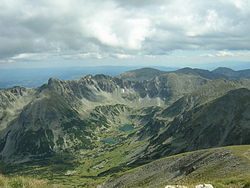
Back Maritsa Afrikaans ماريتسا Arabic نهر ماريتسا ARZ Maritsa çayı Azerbaijani ماریتسا چایی AZB Марыца Byelorussian Марица Bulgarian Maritsa Breton Maritsa Catalan Maritsa River CEB
| Maritsa Évros, Meriç | |
|---|---|
 The source valley of the Maritsa river in the Rila Mountains with Marichini Lakes | |
| Native name | |
| Location | |
| Countries | |
| Physical characteristics | |
| Source | |
| • location | Rila Mountains, Bulgaria |
| • elevation | 2,378 m (7,802 ft) |
| Mouth | |
• location | Aegean Sea, 14.5 km (9.0 mi) east of Alexandroupoli |
• coordinates | 40°43′50″N 26°2′6″E / 40.73056°N 26.03500°E |
| Length | 480 km (300 mi) |
| Basin size | 53,000 km2 (20,000 sq mi)[1] |
| Discharge | |
| • average | for mouth 234 m3/s (8,300 cu ft/s)[2] |

Maritsa or Maritza (Bulgarian: Марица [mɐˈrit͡sɐ]), also known as Meriç (Turkish: Meriç [meɾit͡ʃ]) and Evros (Greek: Έβρος [ˈevros]), is a river that runs through the Balkans in Southeast Europe. With a length of 480 km (300 mi),[3] it is the longest river that runs solely in the interior of the Balkan peninsula, and one of the largest in Europe by discharge. It flows through Bulgaria in its upper and middle reaches, while its lower course forms much of the border between Greece and Turkey. Its drainage area is about 53,000 km2 (20,000 sq mi), of which 66.2% is in Bulgaria, 27.5% in Turkey and 6.3% in Greece.[1] It is the main river of the historical region of Thrace, most of which lies in its drainage basin.
It has its origin in the Rila Mountains in Western Bulgaria, its source being the Marichini Lakes. The Maritsa flows east-southeast between the Balkan and Rhodope Mountains, past Plovdiv and Dimitrovgrad in Bulgaria to Edirne in Turkey. East of Svilengrad, Bulgaria, the river flows eastwards, forming the border between Bulgaria (on the north bank) and Greece (on the south bank), and then between Turkey and Greece. At Edirne, the river meets it two chief tributaries Tundzha and Arda, and flows through Turkish territory on both banks. It then turns towards the south and forms the border between Greece on the west bank and Turkey on the east bank all the way to the Aegean Sea, which it enters near Enez, forming a river delta. The upper Maritsa valley is a principal east–west route in Bulgaria. The unnavigable river is used for hydroelectric power generation and irrigation.
- ^ a b "Preliminary Flood Risk Assessment" (in Greek). Ministry of Environment, Energy and Climate Change. p. 90. Archived from the original on 15 February 2020.
- ^ inweb.gr
- ^ Statistical Yearbook 2017, National Statistical Institute (Bulgaria), p. 17
© MMXXIII Rich X Search. We shall prevail. All rights reserved. Rich X Search